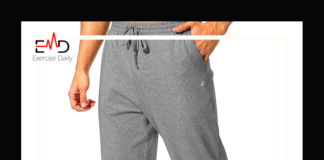Table of Contents
Exercise Daily – If you have an upcoming tooth extraction, you may be anxious to start healing after surgery.
However, it would help if you did not rush back to exercising as soon as your extraction surgery is complete. You will need to give your recovery time, and your doctor can give you specific instructions to guide your recovery journey.
While no one enjoys going through surgery, dental extractions generally aren’t a significant concern. After this procedure, you will want to pay close attention to the healing process.
This blog post will explore the timeline for tooth extraction when it’s safe to begin exercising again after tooth extraction, which exercises to do, and many more questions in your mind.
Keep reading to learn more….
Well, the main question is how long you should wait to exercise after tooth extraction.
For most people, after tooth extraction, it is recommended to wait at least 24 hours before exercising again and 2-3 days before doing any strenuous activity.
You should also eat soft foods like soups, smoothies, etc. During this time, you should avoid chewing on the extraction area.
After 2-3 days, you may be able to return to your regular exercise regime. However, you should wait at least 30 days before returning to strenuous activity, such as running and high-impact sports. It would be best if you also avoided any activities that involve pressure on the extraction area.
As we know, tooth extraction is a surgical procedure that removes a tooth from the mouth. It can be for many reasons, including tooth decay, damage or trauma, and infection.
Although tooth extractions are simple procedures, they can sometimes be painful. If you have had a tooth extracted, you need to take it slow in your recovery.
Here are some things to keep in mind so that your complete recovery can go smoothly:
Time:
After the tooth removal, you must wait at least 24 hours before you start exercising again. Exercising right after a tooth is removed could risk damaging the stitches and the wound site.
Activity:
Exercise can be a great way to relieve stress, improve mood, and strengthen your cardiovascular health.
However, it would help if you did not exercise right after a tooth was removed. Exercising too soon after your procedure could lead to bleeding or infection.
Pain:
Pain is a common symptom of tooth extraction. The dentist may prescribe a pain killer to ease your pain.
Pain medication should be the last thing that you take before your surgery.
What exercises are not recommended after tooth extraction?
You should avoid doing the following exercises for at least 1 week after tooth extraction:

- Aerobic exercise involves the chest and lungs, such as running.
- Swimming.
- Sports, such as basketball or tennis.
- Sports that involve running or jumping, such as volleyball or soccer.
- Sports require you to be in a vertical position, such as gymnastics or basketball.
- Exercises involving the upper body include push-ups, pull-ups, and chest presses.
- Exercises that require you to lie down, such as yoga and Pilates.
- Exercises involving the lower body include lunges, squats, and sit-ups.
Activities to avoid after tooth extraction:
Now we will explore what activities you should avoid after your tooth extraction.
After tooth extraction, it is essential to follow specific steps for quick and efficient healing.
Your dentist may prescribe pain medications, but in many cases, some activities can interfere with the recovery process.
Failing to follow your dentist’s instructions may delay healing, causing complications in the future.
Here are some activities to avoid after tooth extraction:
Smoking:
Smoking can delay the healing process after tooth extraction. Smoking constricts the blood vessels and reduces blood flow to the area, thus affecting the process of healing.
Also, smoking can aggravate the pain and discomfort generally experienced after tooth extraction.
Moreover, smoking can hinder the healing process, affect the long-term results, and can lead to other health complications in the future.
Eating hard foods:
After tooth extraction, chewing on hard foods can disturb the surgical site. Hard foods can disrupt the blood clot formed at the surgical site, resulting in an incomplete healing process.
Drinking alcohol:
Alcohol consumption can interfere with the healing after tooth extraction. Alcohol can reduce the number of fluids in the body, thereby delaying the healing process.
Also, drinking alcohol can hinder the healing process and result in other complications in the future.
What exercises are safe after tooth extraction?
After tooth extraction, avoid strenuous exercises for at least 2-3 weeks. Mild exercises are tolerated, such as walking for 20 minutes.
How exercising can affect a tooth extraction site?

Regular exercise can help reduce swelling and aid in healing post tooth extraction, but the type of exercise you do can significantly impact your tooth extraction site.
Exercise helps to improve blood flow in the body, including in the jaws, leading to faster healing. Exercise also increases the amount of oxygen in the blood, which speeds up the healing process.
Exercising can also increase the blood volume in the body, which is beneficial for healing. Exercise also increases the rate at which your body releases endorphins, chemicals that act as natural painkillers.
Conclusion:
Now that you understand how long you should wait to exercise after tooth extraction, you may wonder when it is safe to exercise again. Some doctors recommend waiting at least three weeks after surgery to exercise. Your doctor will tell you how long you should wait to exercise based on your overall health, your age, and the type of operation that you had. We hope this article has given you a better understanding of when it is safe to exercise again and some helpful tips for a speedy recovery.
Frequently Asked Questions:
How long after having a tooth pulled can you run?
A tooth pulled by the oral surgeon is usually completely healed in 10 days. Your dentist will determine whether or not you can run before ten days as long as your stitches are healing correctly.
People usually feel well enough to run again after about an hour, though some activities, such as swimming or bicycle riding, may be challenging immediately.
The length of time it takes to heal depends on the severity of the pain, which is a sign that the stitches are healing correctly. The stitches may take several weeks to heal if there’s no pain.
Can I take a walk after tooth extraction?
Yes, you can. However, it would be best if you took it easy for the first several days of recovery because you might be more sensitive to pain.
Avoid strenuous exercise immediately following tooth extraction; after resting for 30 minutes, walk some.
How long should you wait to exercise after a wisdom tooth?
Exercise is not recommended after tooth removal, as the best recovery time is within the first two days.
For three days, avoiding vigorous activity and using a soft diet is a good idea. Make sure that the stitches do not break before the third day.
If the stitches are too tight, they can irritate your cheek and gum. Between your second and third day, you can start light exercises using your jaw muscle.
After that, you can begin light exercises for your abdominal muscles, chest, and shoulders.
Can I lift weights after tooth extraction?
If a patient has undergone a tooth extraction, then they will be advised not to lift weights.
Lifting weights after tooth removal may cause complications that include slower healing, infection, and post-operative pain.
Tooth removal surgery is the greater risk, and post-operative complications may include jaw swelling, infection, and facial nerve damage.
Can I cycle after tooth Extraction?
Yes, you can, but you shouldn’t do it unless you are coming from surgery or a hospital.
After tooth extraction, some patients report continued soreness, discomfort, and bleeding. During this period, you should avoid cycling. After you have completely recovered, you can return to cycling.





